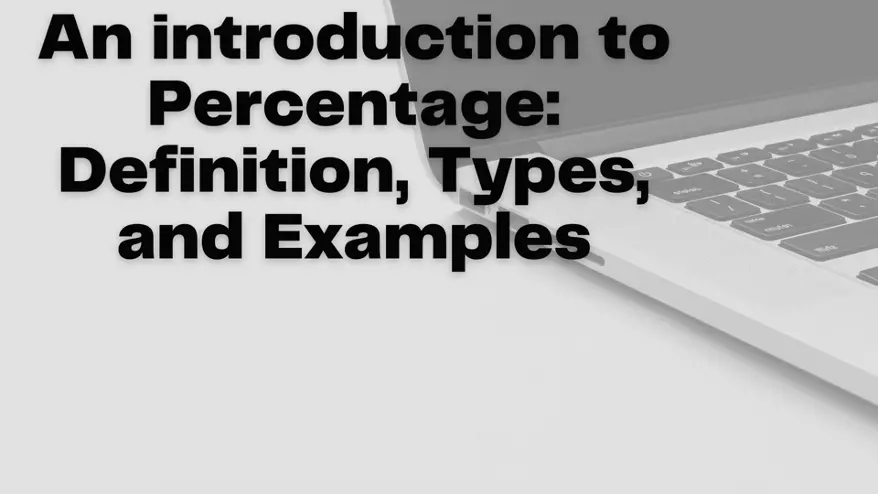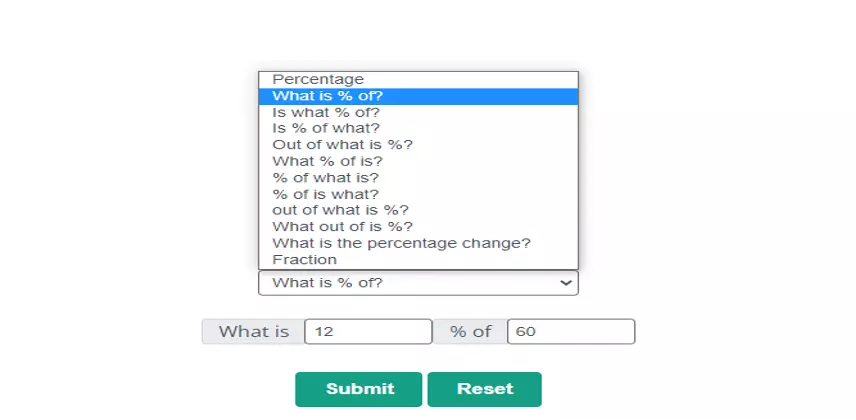An introduction to Percentage: Definition, Types, and Examples
|
Percentages are extensively utilized in a variety of circumstances. For example, discounts in shops, bank interest rates, rates of inflation, and many statistics in the media are expressed as percentages. Percentages are important for understanding the financial aspects of everyday life. We will learn about the percentage, examples, and applications in the real world. |
 |
What is the percentage?
Percentage means out of a hundred. It is represented by the sign %. The percentage is represented by any number or ratio with the denominator 100. Percentage is derived from the Latin word “PERA CENTUM” which means “by the hundred.
Whenever we need to find a percentage we have to divide the given value by the total number of values and then multiplied by 100.
1. Decimal to Percentage
When we have a given value in decimal form, we just multiplied by 100 to change it into a percentage.
Example:
Change the 0.782 in the form of a percentage.
Solution: To change the given value into a percentage just multiplied by a hundred.
(0.782 * 100) % = 78.2 %
2. Fraction into Percentage
We can change the fraction into a percentage we just multiplied the value by 100. In this way, we understand what percentage of the nominator to the given denominator.
Example:
The fraction finds the percentage of the given fraction.
Solution:
We have to follow the method to change the given fraction into a percentage just multiplied by 100.
- [(12/25) * 100] %
- [0.48 * 100] %
- 48 %
Examples of percentage
We discuss here some examples in detail to understand the analytical way of percentage.
Example 1:
Find the 25.5 percentage of 600.
Solution:
Method 1:
Step 1: Write the data from the given information.
x =? Percentage of = 600, Percent= 25.5
Step 2: Use the formula to solve
600/x = 100 % /25.5
Step 3: Take the reciprocal of both sides and gives the:
x/600 = 25.5 / 100%
x = [25.5/ 100 %]* 600
x = (0.26) * 600
x = 153
Therefore, 25.5 % of 600 is 153.
Method 2:
Step 1: According to the given statement
25.5 % of the 600
Step 2: Replace by with multiplication sign
25.5 % *600
Step 3: Change percentage into fraction form
(25.5 /100) * 600
Step 4: Simplify the given values
(255/1000) *600
153
Example 2:
In grade 5 Lilly among 70 students 40 students wear glasses and remain without glasses.
- Find the percentage of students who wear glasses.
- Find the percentage of students who do not wear glasses.
Solution:
Step 1: Find the percentage of students who wear glasses and without glasses
Total students = 70
Number of students wearing glasses = 40
Number of the students without glasses = 70 – 40 = 30
Step 2: Write the formula which is applied to find the percentage
Percentage of the students wearing glasses = * 100
Step 3: Put the values in the corresponding formula
Percentage of the students wearing glasses = (40/70) * 100
Percentage of the students wearing glasses = 57.14 %
Step 4:
Percentage of the students who do not wear glasses = (30/70) * 100
Percentage of the students who do not wear glasses = 42.86 %
Hence 57.14 % of students are with glasses and 42.86 % of students are without glasses.
To avoid mixing with the different methods, you can use a percentage calculator. It saves our time and increases accuracy.

The following steps are fellow to calculate the result.
- Select the type of problem involving percentage.
- Give the input into cross-ponding boxes.
- Click the submit button to calculate the result.
Example 3:
What is the percentage of 20 out of 90?
Solution:
Step 1:
Write the formula
P% = V/U
Step 2: Put the values in the corresponding formula
P % = 20/90
Step 3: Change the fraction into a percentage
P % = 20/90
P % = 0.2222
Step 4: To change into percentage we have to multiply the decimal value by 100.
P % = (0.2222 * 100) %
P % = 22.22 %
Hence 20 out of 90 is 22.22 %.
Example 4:
Suppose a bag contains 2 kg of mangoes and 3 kg of grapes. Determine the ratio of the amounts present, as well as the percentage occupied by each.
Solution:
The number of mangoes and grapes in a bag may be compared using their ratio, which is 2:3.
The following is how percentages are really interpreted:
The same quantity may be described in terms of the % occupied, as shown below.
5 kg total amount present.
The ratio of mangoes = 2/5
The percentage ratio of mangoes = (2/5) *100
The percentage ratio of mangoes = 40 %
Percentage of grapes = 3/5*100= 60%
Application of percentage
We use the percentage in the different parts of life. We discuss them one by one by one in detail here.
Smartphone battery:
You must have noticed the icon on the top of your smartphone screen, the one that shows the battery. It often shows in percentage. This helps us a lot to gauge the amount of time our phone battery will last for.
Sales in shops:
You know what sales are. There are Valentine’s Day sales, eid sales, Independence Day sales, and many more. You would have noticed that the sales are in a percentage. 60% off.
Exam Results:
Have you ever taken, or seen an exam? You would have noticed that the results come out in percentage. I personally think this gives you a better idea of your marks than a fraction.
Survey results:
At the end of a survey, people often display their results in the form of a percentage, preferably in a pie chart. This gives us a better idea of the number of people who selected something.
Ingredients on the back of the bottle:
Have you ever had any syrup or medicine? Chances are, you have. A few of you may have noticed the ingredients written in percentages on the back of the bottle. This, again helps you gauge the amount of each ingredient.
Summary
In this article, we have learned about the percentage and its real-life applications. You are now able to utilize the percentage concept to enhance your performance in different fields of life.
 English
English
 Bahasa Indonesia
Bahasa Indonesia
 Português
Português


